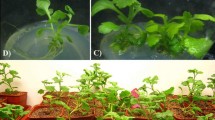Abstract
Successfull application of X-irradiation to obtain viable mutants affecting ray-floret characteristics of annual chrysanthemum is reported. Either strap-shaped flat rays of the control type had strikingly changed in their appearance or were entirely lacking. An interesting mutation resulted in transformation of pistillate nature of the ray florets into bisexual type. The occurrence of mutant phenotypes is genetically accounted for and the usefulness of experimental production of mutations in plant breeding is discussed.
Similar content being viewed by others
References
GaulH., 1958. Present aspects of induced mutations in plant breeding. Euphytica 7: 275–289.
GoldschmidtR. B., 1958. Theoretical Genetics. University of California Press, Berkeley.
GustafssonA. and WettsteinD.von, 1958. Mutationen und Mutationszüchtung. Handb. Pfl. züchtung 1: 612–699.
JainH. K., BoseA. K., SatpathyD., and SurS. C., 1961. Mutation studies in annual chrysanthemum. I. Radiation-induced variation in flower form. Indian J. Genet. & Pl. Br. 21: 68–74.
JankH., 1957. Experimentelle Mutationsauslösung durch Röntgenstrahlen bei Chrysanthemum indicum. Züchter 27: 223–231.
Mackey, J., 1961. Methods of utilizing induced mutations in crop improvement. In: Mutation and Plant Breeding NAS-NRC 891: 336–361.
PrakkenR., 1959. Induced mutations. Euphytica 8: 270–322.
RanaR. S., JainH. K. and NerwalS. K., 1963. Variable expressivity of an induced dominant mutant of Cosmos. Indian J. Genet. & Pl. Br. 23: 325–330.
SagawaY. and MehlquistG. A. L., 1957. The mechanism responsible for some X-ray induced changes in flower colour of the carnation, Dianthus caryophyllus. Amer. J. Bot. 44: 397–403.
SagawaY. and MehlquistG. A. L., 1959. Some X-ray induced mutants in the carnation. J. Hered. 50: 78–80.
SamataY., 1964. Genetic studies on Cosmos bipinnatus. VI. Morphological development of flower-heads by the action of flower-type genes. (2) In doubled types. Jap. J. Breed. 14: 40–46.
SingletonW. R., KonzakC. F., ShapiroS. and SparrowA. H., 1956. The contribution of radiation genetics to crop improvement. Proc. Int. Conf. Peaceful Uses Atomic Energy, UN, Geneva 12: 25–30.
SmithH. H., 1958. Radiation in the production of useful mutations. Bot. Rev. 24: 1–24.
SparrowA. H. and KonzakC. F., 1958. The use of ionizing radiation in plant breeding. Accomplishments and prospects. Camellia Culture (Ed. E. C.Tourje). McMillan Co., New York.
StubbeH., 1958. Advances and problems of research in mutations in the applied field. Proc. X Int. Congr. Genetics Vol. 1: 247–260.
Swaminathan, M. S., 1958. Induction of mutations in fruit trees — problems and techniques. Hort. Symp., 1958, New Delhi.
WettsteinD.von, 1960. Multiple allelism in induced chlorophyll mutants of barley. Hereditas 47: 767–770.
Author information
Authors and Affiliations
Rights and permissions
About this article
Cite this article
Rana, R.S. Radiation-induced variation in ray-floret characteristics of annual chrysanthemum. Euphytica 14, 296–300 (1965). https://doi.org/10.1007/BF00149515
Received:
Issue Date:
DOI: https://doi.org/10.1007/BF00149515




